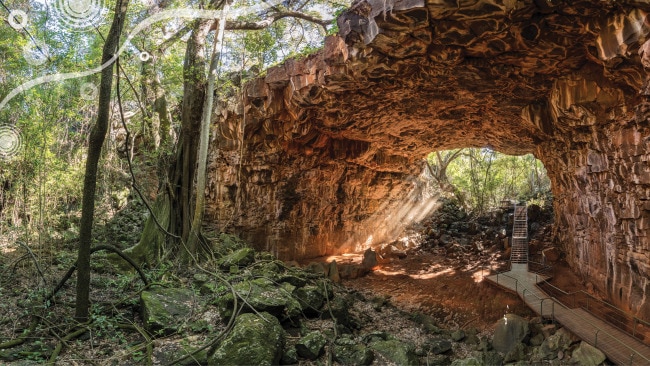Flight for life
Michael Tomlinson is lucky to be alive. Thanks to the Royal Flying Doctor Service and Brisbane Airport Corporation, he is able to share his amazing story.

Michael Tomlinson is lucky to be alive. Thanks to the Royal Flying Doctor Service and Brisbane Airport Corporation, he is able to share his amazing story.
Young grazier Michael Tomlinson sat in water up to his neck in a water trough on his family’s cattle property and sucked in some deep breaths, lucky to be alive.
The helicopter he had been piloting minutes before had crash-landed, exploding on impact. Scrambling out of the wreckage, intact but badly burned, he headed for the bore to wait for help.
Tomlinson didn’t know it at the time but he was still in grave danger, and only an epic effort by multiple individuals and agencies working against the clock would ensure he lived to see another sunrise.
The drama unfolded on a hot January afternoon in 2013 at the Tomlinson property near Augathella, about 700km west of Brisbane. Tomlinson, 27 at the time, was mustering cattle in the helicopter when its engine started to fail.
“I made an emergency landing in a little erosion gully,” recalls Tomlinson.
“Because I still had a bit of pace on board, the skid wedged into the soil and rolled the machine over. The fuel tank split and it exploded while I was still inside.
“I quickly realised I had to get out of there, so I jumped out and ran to a water hole that was about a kilometre away.”
Michael’s younger brother Sam was nearby on a motorbike and saw the crash. When he reached the wreckage there was no sign of Michael and he began searching.
“I sat in the water for about an hour before my brother eventually found me,” he said. “I told him: ‘Don’t worry, I’m not going to cark it but it would be pretty good to get some help’.”
What happened next is nothing short of a miracle — a miracle that is played out all too often when people living in remote areas find themselves in urgent need of medical attention.
The Royal Flying Doctor Service was alerted to Michael’s plight and dispatched a plane from its Charleville base 85km away with Dr Charles Ellis and flight nurse Mark Davis on board.
The Tomlinsons’ airstrip was too short for the RFDS to land on so an ambulance was sent to take Tomlinson to Augathella Hospital, where he was stabilised in preparation for the flight to Brisbane.
“He had burns to around 70 per cent of his body,” Dr Ellis remembers.
“When somebody has burns to that degree it’s pretty scary and you need to make sure you do all the right things to give them every chance of surviving.”
Severe burns can result in multi-organ failure and correct early treatment is critical to the patient’s chances of survival. Dr Ellis was concerned that burnt tissue near his airways could swell and restrict breathing, so the RFDS team worked with the hospital staff to sedate him and insert a tube to protect his airway.
He was given fluids, antibiotics and tetanus vaccine to guard against infection.
Dr Ellis spoke to Michael’s dad Bill and told him how grave the situation was. He promised Bill he would do everything he could to save his son.
“If it hadn’t been for the Flying Doctors I don’t think he would have survived,” said Bill. “It was pretty reassuring seeing him head off with people who knew what they were doing.”
Tomlinson now knows how precarious his hold on life was in those first few hours.
“Dr Ellis told me that there were a few times when my organs started to shut down. I was on the edge of death.”
The RFDS medical team had a nervous two-hour flight getting Tomlinson to the expert medical attention that awaited him at the Royal Brisbane and Women’s Hospital burns unit. His heart rate remained high and the appropriate fluid intake was critical. Fluid loss can cause renal damage and too much fluid could result in respiration complications.
“It’s quite a balancing act,” says Dr Ellis, who sought advice from specialists at the burns unit while en route. As the plane approached its destination, a vital partnership between the RFDS and the Brisbane Airport Corporation was activated. Emergency medical flights are given priority over all other aircraft landings by the air traffic controllers at Brisbane Airport.
“Without the Flying Doctors It would have taken eight hours by road to get me to a Brisbane hospital, and at that time of the year the roads are often closed due to flooding,” Tomlinson says.
He spent six weeks in an induced coma, endured 16 major operations and staying in hospital almost four months. But he survived.
Now living in Toowoomba and working as a property agent, married to Anna with a daughter Libby, 2, and another baby imminent, Tomlinson doesn’t remember much about the RFDS flight, but he knows one thing.
“I am sure that if I didn’t have them there, I most likely wouldn’t be here to tell the tale,” he says. “So I was pretty fortunate they were about.”
Fast facts
■ Brisbane Airport Corporation has been a principal partner of RFDS Queensland since 2009, donating more than $2.9 million to help with their life-saving work.
■ In 2018, 160 emergency flights were given priority landings at Brisbane Airport.
■ Each year, RFDS aeromedically transfers more than 11,000 patients across Queensland.
■ Since 2009 RFDS has landed at Brisbane Airport more than 28,000 times.
Learn more about the RFDS here
Originally published as Flight for life


